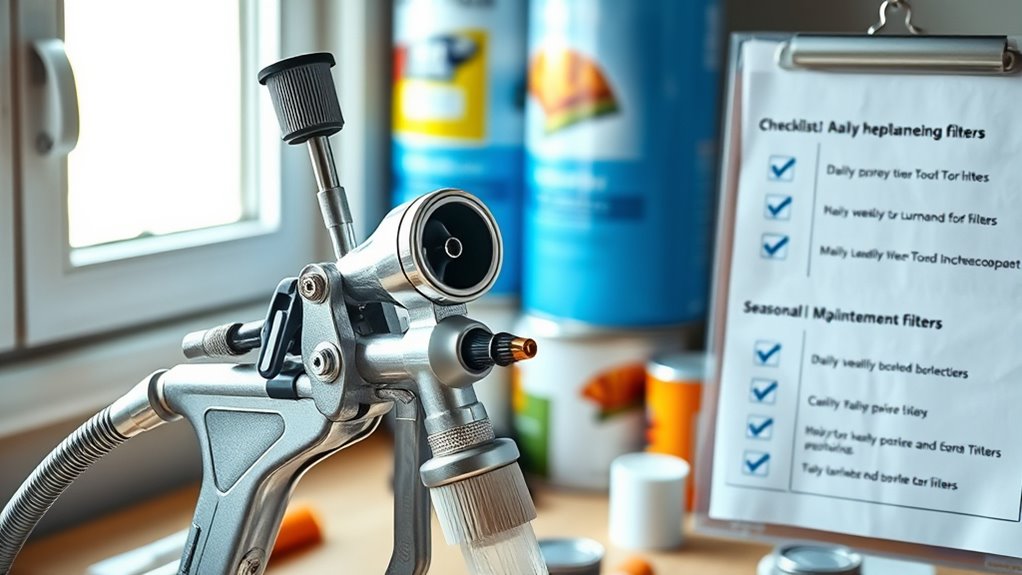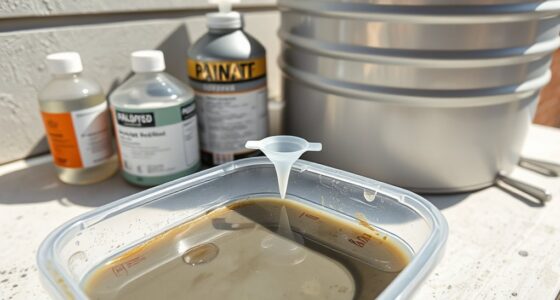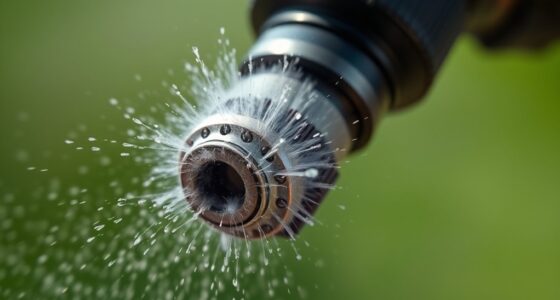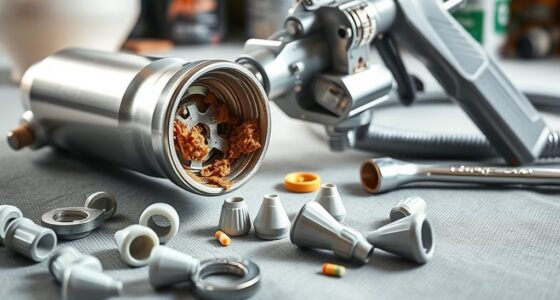To keep your paint sprayer running smoothly, perform daily checks by inspecting hoses, nozzles, and filters for clogs or leaks, and troubleshoot issues promptly. Weekly, disassemble and clean major parts, replace worn seals, and calibrate the equipment for consistent results. Seasonally, inspect for corrosion, drain residual paint, and upgrade worn-out components. Following these routines can prevent problems and extend your sprayer’s life—stick with us to learn detailed steps for each interval.
Key Takeaways
- Perform daily inspections of hoses, filters, and nozzles; address issues like clogs, leaks, or inconsistent spray immediately.
- Clean major components, including spray guns and nozzles, weekly to remove paint residues and maintain optimal performance.
- Check seals, gaskets, and electrical connections seasonally; replace worn parts and prevent leaks or corrosion.
- Calibrate the sprayer weekly to ensure consistent spray patterns and material flow for professional results.
- Follow safety protocols during all maintenance routines, including disconnecting power and wearing appropriate protective gear.
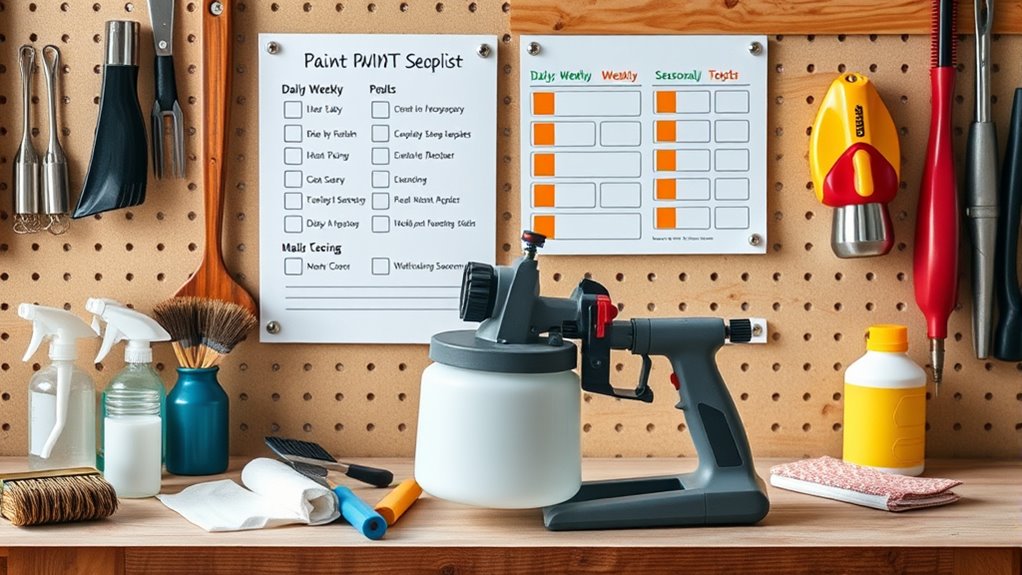
Regular maintenance is vital to keep your paint sprayer functioning smoothly and guarantee high-quality results. By staying on top of daily, weekly, and seasonal upkeep, you can prevent costly repairs and ensure your equipment performs reliably. One of the most important aspects of daily maintenance is addressing equipment troubleshooting promptly. If you notice inconsistent spray patterns, clogs, or leaks, it’s essential to identify the root cause quickly. Regularly inspecting hoses, filters, and nozzles helps you catch issues early, reducing downtime. Always follow safety protocols when troubleshooting, such as disconnecting power sources before inspecting or cleaning parts. Wearing gloves and eye protection prevents injuries from chemicals or flying debris, especially when dealing with pressurized components. Keeping your workspace clean and organized allows you to spot potential problems faster and prevents accidental damage to sensitive parts. Proper cleaning of spray gun components with suitable cleaning agents is also crucial to maintain optimal performance.
Weekly maintenance involves more thorough checks and cleaning routines. You should disassemble and clean major components like the spray gun, nozzle, and filters to remove paint residues that can cause clogs. It’s also a good time to inspect seals and gaskets for signs of wear or damage, replacing them if necessary. Lubricating moving parts, such as triggers and switches, ensures smooth operation and reduces strain on the internal mechanisms. During these checks, review your safety protocols to confirm that all safety equipment is functional and that you’re following best practices for handling chemicals and pressurized systems. Regular calibration of your sprayer helps maintain consistent spray patterns and material flow, which is essential for achieving professional results. Documenting maintenance activities can help you track recurring issues and plan for seasonal upgrades or repairs. Additionally, examining and replacing worn-out or damaged hoses can prevent leaks and improve overall efficiency.
Seasonal maintenance is more thorough and often coincides with major project cycles or weather changes. This includes inspecting the entire system for corrosion, especially if you’ve stored the sprayer for an extended period. Drain any remaining paint and clean internal components thoroughly to prevent buildup or deterioration. Check and replace any worn-out hoses, seals, or electrical connections to avoid leaks and electrical hazards. It’s also wise to review your safety protocols, ensuring that all protective gear is in excellent condition and that your workspace complies with safety standards. Seasonal maintenance might also involve upgrading parts or applying manufacturer-approved lubricants and cleaning agents to extend the lifespan of your equipment. By following a structured seasonal checklist, you can prevent unexpected breakdowns and keep your paint sprayer ready for the next big project, all while adhering to safety protocols and troubleshooting effectively when issues arise. Maintaining equipment longevity through proper care ensures your investment remains reliable for years to come.
Frequently Asked Questions
How Often Should I Replace My Paint Sprayer’s Seals?
You should replace your paint sprayer’s seals during your maintenance schedule or if you notice leaks, loss of pressure, or inconsistent spray patterns. Generally, seals need replacement every 6 to 12 months, but this varies based on usage and paint type. Regular seal replacement guarantees peak performance and prevents costly repairs. Keep an eye on your sprayer’s condition and adhere to your maintenance schedule for the best results.
What Are Signs of a Clogged Spray Tip?
You notice your spray pattern becoming uneven or sputtering unexpectedly—that’s a sign of a clogged spray tip. A clogged nozzle often causes inconsistent flow, leading to drips or blobs. You might also see reduced spray pressure or uneven coverage. Don’t ignore these signs; they hint at a blocked spray tip that needs cleaning. Act quickly to restore your sprayer’s performance and guarantee a smooth, flawless finish.
Can I Use Any Cleaning Solvent for Maintenance?
You shouldn’t use just any cleaning solvent for maintenance. Always check that the cleaning solvents you choose are compatible chemicals with your paint sprayer’s materials. Using incompatible solvents can damage seals, nozzles, or internal parts. Opt for manufacturer-recommended cleaning solutions or those specifically designed for your sprayer type. This guarantees effective cleaning without risking damage, keeping your equipment in top condition and extending its lifespan.
How Do Temperature Changes Affect Sprayer Performance?
Did you know that temperature fluctuations can reduce a sprayer’s efficiency by up to 30%? When temperatures change, moisture effects become a concern, as cooler air can cause condensation inside your equipment. This moisture can clog nozzles or cause uneven spray patterns. To maintain ideal performance, avoid spraying in extreme temperatures, and let your equipment reach a stable temperature before use. Proper handling ensures consistent, high-quality results.
Is It Necessary to Calibrate the Spray Pattern Regularly?
Yes, you should calibrate your spray pattern regularly to maintain spray pattern consistency. Regular calibration helps guarantee even coverage and prevents uneven paint application. Use nozzle adjustment tips to fine-tune the spray pattern, making sure it matches your desired output. By doing this consistently, you improve the quality of your work, reduce paint waste, and extend your sprayer’s lifespan. Don’t overlook this vital step for ideal spray performance.
Conclusion
Think of your paint sprayer as a trusted steed, requiring regular care to stay swift and strong. With daily, weekly, and seasonal checklists, you’re tending to its needs, ensuring it’s always ready for the next adventure. When you stay attentive, your sprayer will glide smoothly, like a well-trained horse, delivering flawless results every time. Keep up the maintenance, and your tools will carry you effortlessly through every project, turning work into a rewarding journey.
Franz came aboard the Paint Sprayer Zone team with a background in both journalism and home renovation. His articulate writing style, combined with a passion for DIY projects, makes him an invaluable asset. Franz has a knack for breaking down technical jargon into easy-to-understand content, ensuring that even the most novice of readers can grasp the complexities of paint sprayers.
